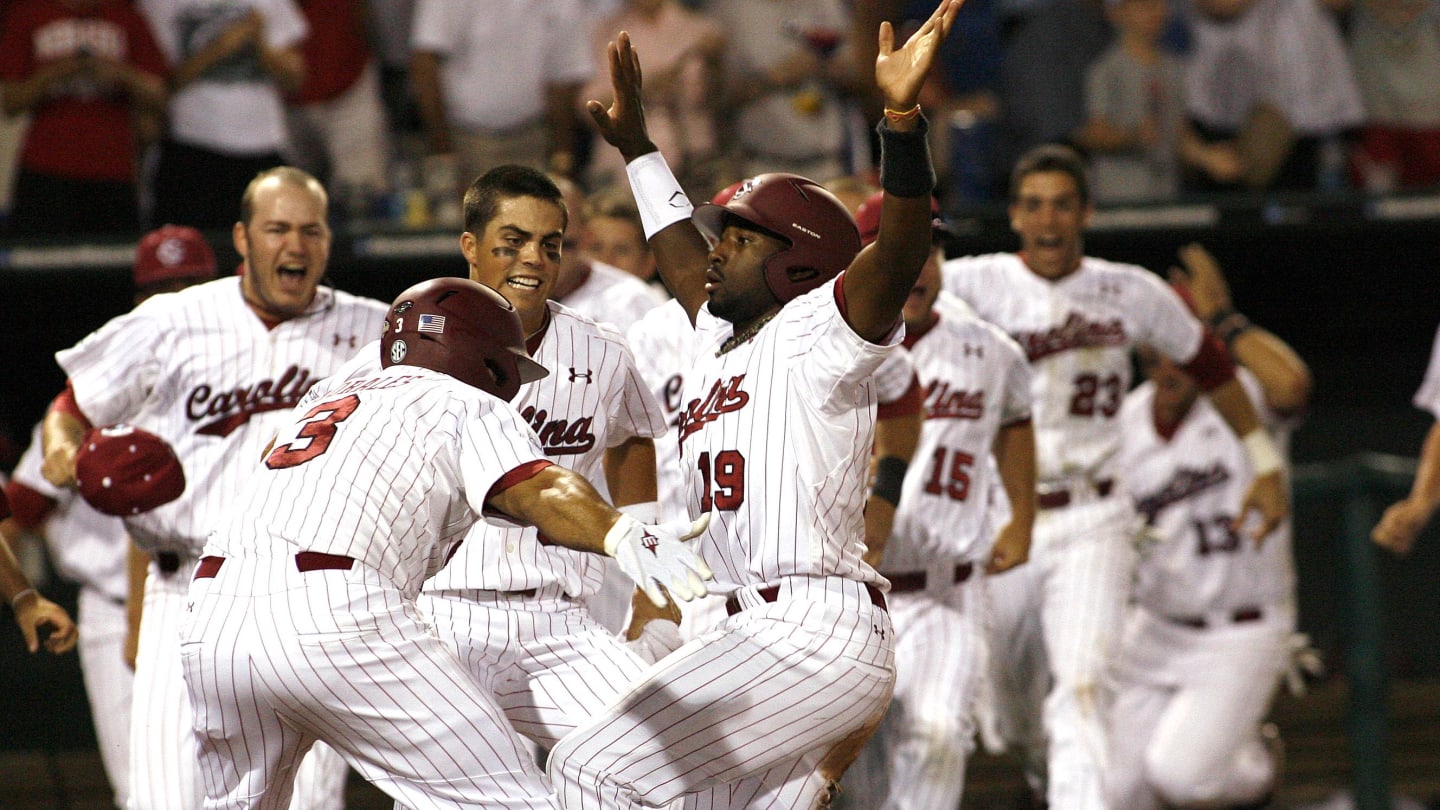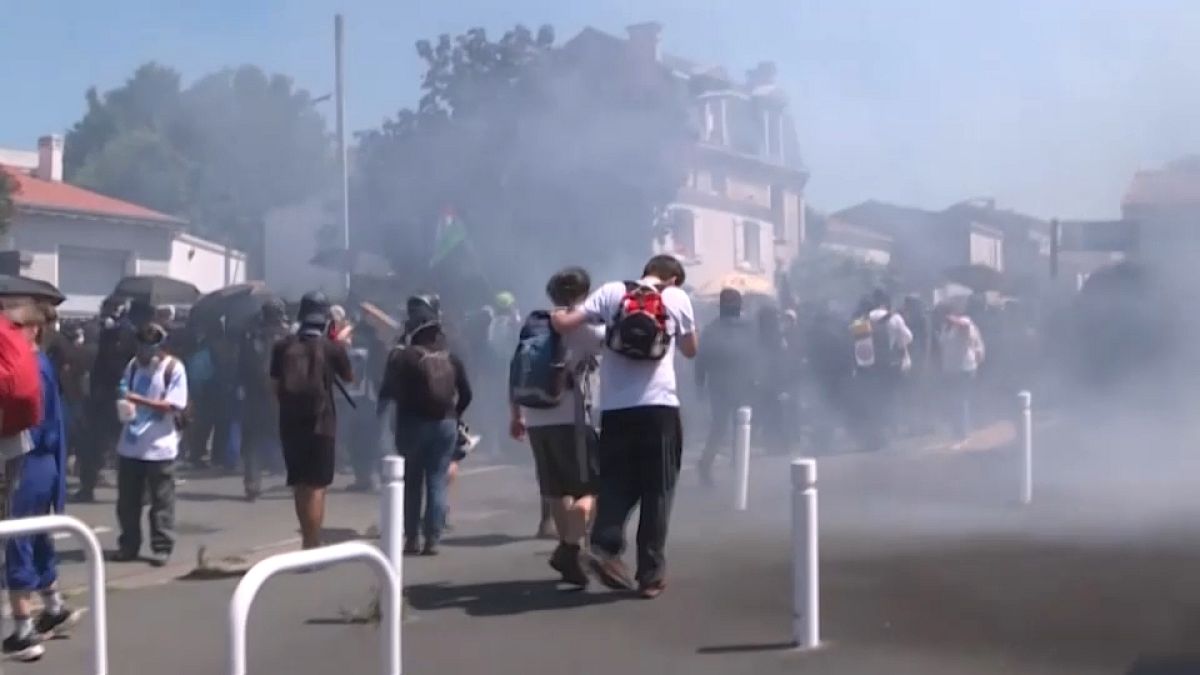Midwest
Meet the American who gave flight to football, Bradbury Robinson, college star threw first forward pass
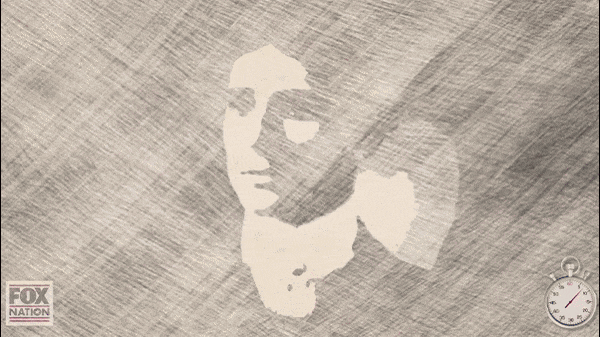
Imagine the United States of America without football — our most popular sport and a cherished cultural spectacle.
No Friday night lights, Saturday afternoon madness or Super Bowl Sunday.
It nearly happened. Gruesome violence on the gridiron in the early 1900s spurred calls from pigskin prohibitionists to spike football.
St. Louis University star Bradbury Robinson was the first player to take a shot downfield to save football and beat the blitz that threatened to sack the popular but deadly sport.
FOX NATION’S NEW SERIES ‘MEET THE AMERICAN WHO’ TELLS OF ORDINARY AMERICANS WHO GAVE US EXTRAORDINARY INNOVATIONS
Robinson threw the first forward pass, and then the first touchdown pass, in the history of football.
His “Blue and White” beat Carroll College, 22-0, on Sept. 5, 1906, in Waukesha, Wisconsin.
Bradbury Robinson was a three-sport star and medical student at St. Louis University when he threw the first forward pass, and the first touchdown pass, in the history of football on Sept. 5, 1906. St. Louis University beat Carroll College 22-0, in a game played in Waukesha, Wisconsin. (Public Domain)
“I had worked on forward passing, and at the time the pass was introduced I was the only finished passer in the country,” Robinson said while speaking about his role in sports history at a conference in 1947.
The forward pass was a regulatory Hail Mary — a longshot chance to save a sport that had grown wildly popular on high school and college campuses but too deadly for millions of Americans to tolerate.
“I had worked on forward passing, and at the time the pass was introduced I was the only finished passer in the country.”
President Theodore Roosevelt called an audible from the White House that launched a new era in the history of the sport — and in America’s cultural heritage.
“Football was incredibly brutal and violent at the turn of the century,” author and football historian John J. Miller told Fox News Digital.
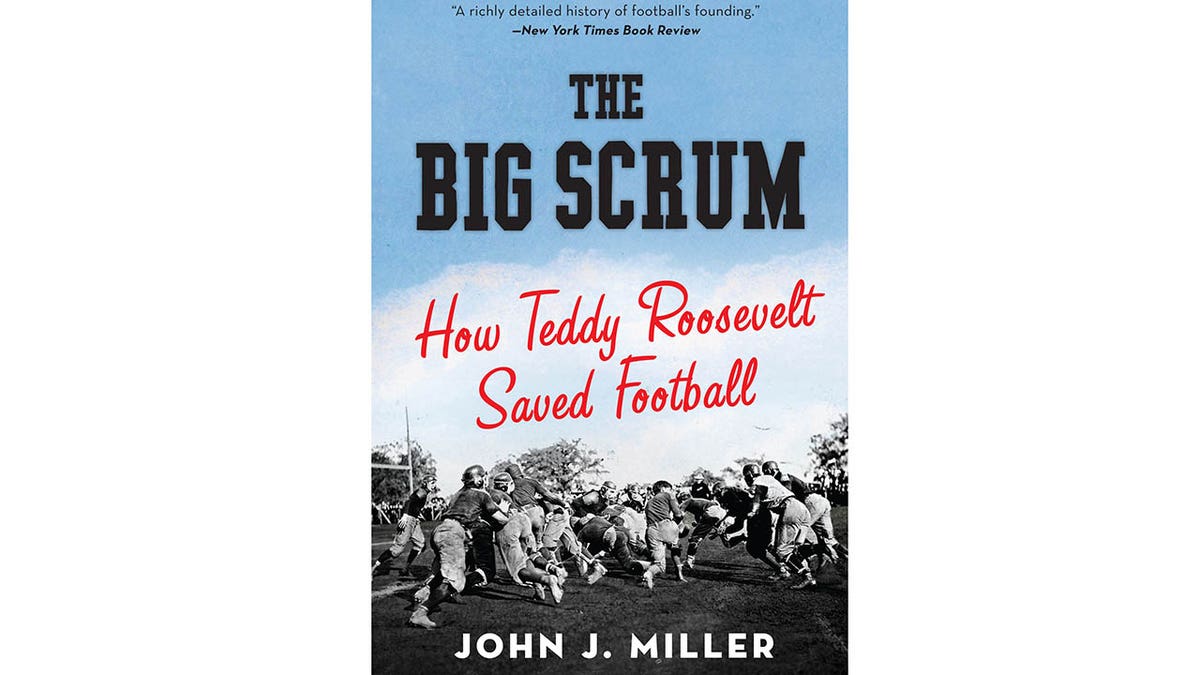
The Big Scrum: How Teddy Roosevelt Saved Football” by John J. Miller chronicles the high-powered effort to make football less deadly and more exciting. (Courtesy HarperCollins)
Miller is a journalism professor at Hillsdale College in Michigan and author of the 2011 book “The Big Scrum: How Teddy Roosevelt Saved Football.”
A total of 48 players were killed on the gridiron between 1900 and 1905, according to several sources.
“Brutality in playing a game should awaken the heartiest and most plainly shown contempt for the player guilty of it,” President Roosevelt said at the time.
MEET THE AMERICAN WHO WAS THE FIRST PAID PROFESSIONAL FOOTBALL PLAYER: PUDGE HEFFELFINGER
The First Football Fan called together college football rule-makers at the end of 1905 season. He demanded they find a way to make the sport safer to quell the anti-football uprising.
The forward pass proved their most important innovation.
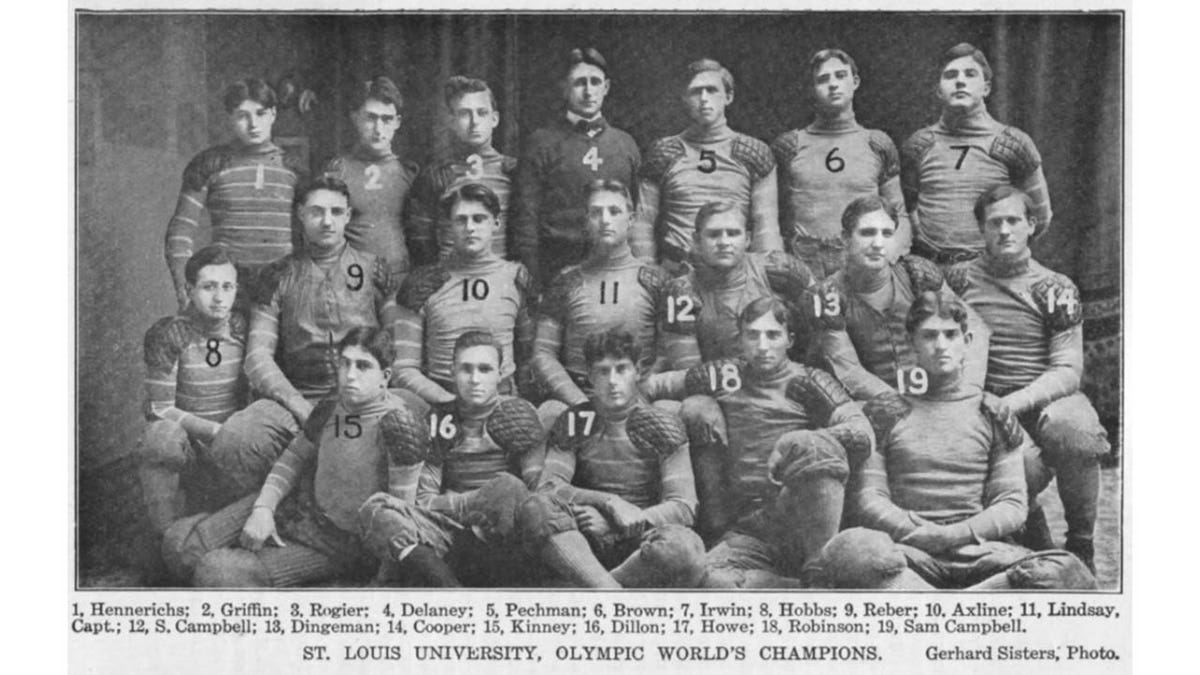
Bradbury Robinson transferred from the University of Wisconsin to St. Louis University before the 1904 season. The powerhouse team participated in the 1904 Olympic Games in St. Louis, where they earned the distinction of the first and only gold medal “Olympic world’s champions” in American football. Bradbury Robinson, who threw the first forward pass in football history in 1906, is front row, second from right. (Public Domain)
“Without Roosevelt and the forward pass, what would have happened to football? Would the prohibitionists have won?” Miller said on NFL Films production “A Football Life: The Forward Pass.”
“Yes, they might have won. Football might have been abandoned. It might have been outlawed. It might have been erased from our cultural landscape.”
Intolerable death toll
Bradbury Norton Robinson Jr. was born on Feb. 1, 1884 in Bellevue, Ohio to Bradbury and Amelia Isabella (Lee) Robinson.
The first football game, a duel between Princeton and Rutgers, had been played only 15 years earlier.
Dad “Brad” Sr. was a Civil War veteran from Massachusetts who spent much of his life working on railroads. Mom Amelia was born in England.
The family moved to Wisconsin when the future pigskin pioneer was a child.
He proved a star high school athlete and made his way to the University of Wisconsin, where he saw playing time with the varsity football team as a freshman in 1903.
“Football might have been abandoned. It might have been outlawed. It might have been erased from our cultural landscape.”
He was reportedly dismissed from the football team after an altercation with another student.
He enrolled in St. Louis University the following season. He became a star on one of the most dominant teams of what was then considered western football.
Among other honors, St. Louis University holds the distinction of being the only team in history to win an Olympic gold medal in American football, according to university archivist Caitlin Stamm.
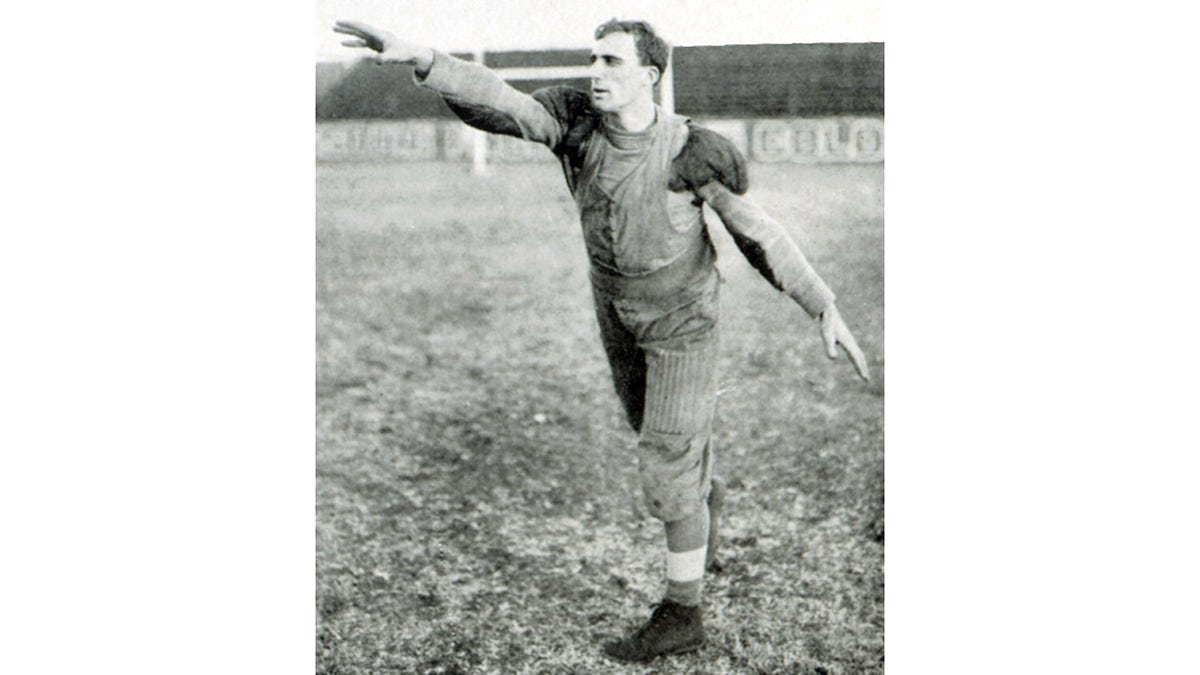
Bradley Robinson of SLU’s Blue and White football team throws the “first” forward pass to John Schneider, in this reconstructed image of the first forward pass in collegiate football, Nov. 3, 1906. (Excerpted from a composite image on page 190 in the SLU Blue and White Yearbook for 1907.) (Courtesy St. Louis University archives)
The 1904 Olympics were held in St. Louis that year, with American football, primarily a college game at the time, one of the featured sports.
St. Louis University went undefeated that year while the popularity of college football swept across the nation.
MEET THE AMERICAN WHO IS THE ‘TRUE FATHER OF BASEBALL,” NEW YORK CITY PHYSICAN DANIEL ’DOC’ ADAMS
But the 1905 season that followed proved intolerably deadly: A shocking 18 high school and college football players were killed on the field of play.
The cries to end the brutality and even ban the game presented political headwinds for the football-loving reformist president.
“President Theodore Roosevelt, whose son was on the freshman team at Harvard University, made it clear he wanted reforms amid calls by some to abolish the college game,” Smithsonian Magazine reported in 2010.
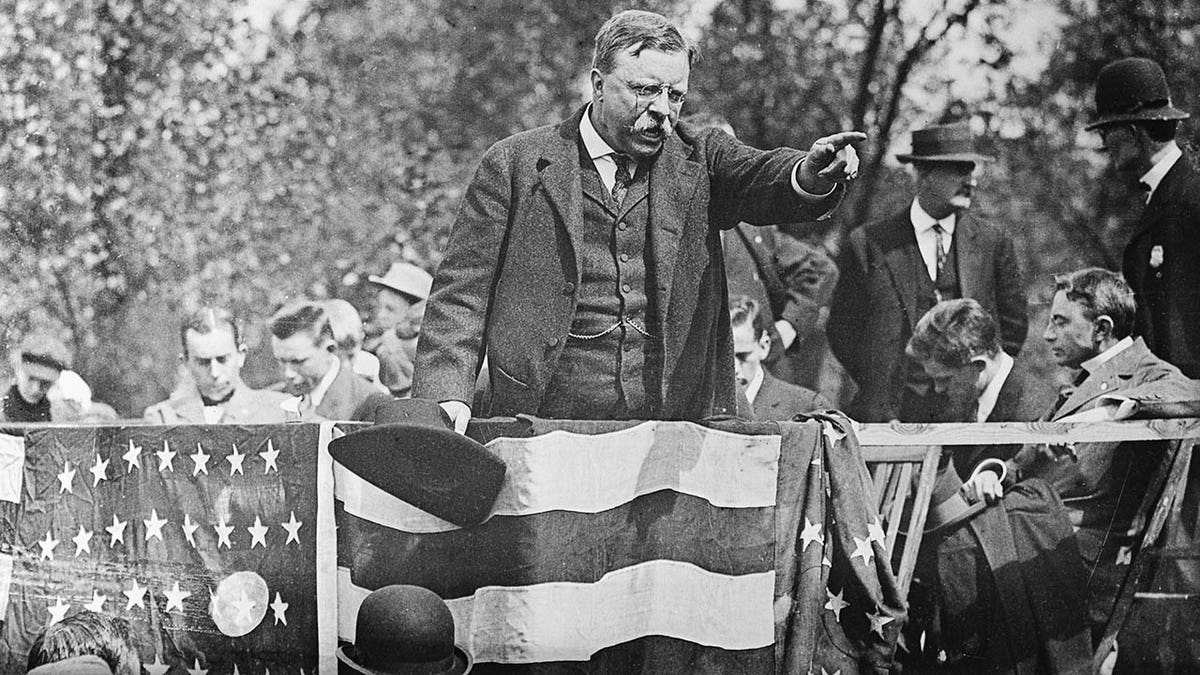
Theodore Roosevelt standing on a podium pointing into the crowd during a campaign rally speech, circa 1900s (original caption). (Getty Images)
University officials from across the nation met in New York City that December.
Smithsonian Magazine added, “They made a number of changes, including banning the ‘flying wedge,’ a mass formation that often caused serious injury, created the neutral zone between offense and defense and required teams to move 10 yards, not 5, in three downs.”
It also said, “Their biggest change was to make the forward pass legal, beginning the transformation of football into the modern game.”
“President Theodore Roosevelt … made it clear he wanted reforms amid calls by some to abolish the college game.”
Robinson reportedly got a heads-up on the pending rule changes from a family friend.
Wisconsin Gov. Robert M. La Follette Sr., according to numerous accounts, shared with Robinson a letter from the president hinting at the potential of the forward pass a year earlier.
Robinson became one of the first people in the nation to practice a new skill that backyard quarterbacks take for granted today: passing the pigskin.
Ball in the ‘shape of a watermelon’
St. Louis University brought in a new coach before that 1906 season: former Wisconsin assistant Eddie Cochems.
The forward-thinking coach was only 29 and apparently knew Robinson from their days at the University of Wisconsin. The football star reportedly urged school authorities to hire the new coach.
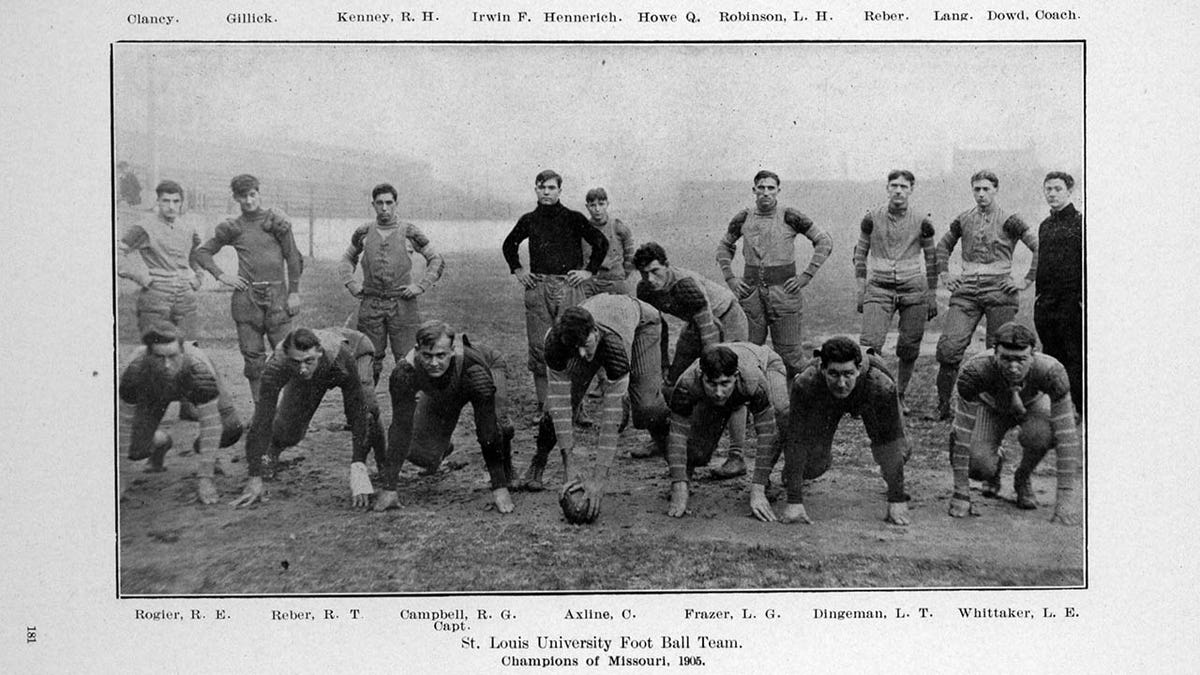
The 1906 St. Louis University football team was the first in history to take advantage of new rules and execute the forward pass. The team went 11-0 and outscored opponents 407-11. (Courtesy St. Louis University archives)
Their game plan to unleash the forward pass was formulated during a team retreat in Wisconsin.
“Cochem brought a team of 16 players to Lakeview, Wisconsin, and used the time to train them on how to use the forward pass,” Stamm, the St. Louis University archivist, told Fox News Digital.
MEET THE AMERICAN WHO CREATED NASCAR: BILL FRANCE SR., DAYTONA SPEED DEMON AND RACETRACK PIONEER
Among other things, players had to learn to throw a spiral.
Robinson proved a natural. He was able to throw a football accurately 40 yards downfield, said Stamm.
It was an incredible testament to his arm strength.

St. Louis University wowed fans at Sportsman’s Park when Bradbury Robinson threw a 48-yard pass on Nov. 3, 1906, in a 34-2 win over Kansas University. Robinson had thrown the first forward pass, and first touchdown pass, in football history earlier that season in a 22-0 win over Carroll College. (Courtesy St. Louis University archives)
“The ball he would have thrown would have been the shape of a watermelon,” said Miller.
Cochems adapted faster than most coaches to the new rules changes.
“Some of the new features are very acceptable,” he said in a preseason edition of the SLU publication Fleur de Lis.
“The ball he would have thrown would have been the shape of a watermelon.”
“I think that the quarterback kick and the forward-pass will develop many spectacular plays before the season closes.”
It took little time for his words to prove prophetic.
For more Lifestyle articles, visit foxnews.com/lifestyle
St. Louis University opened the 1906 season on September 5 against Carroll College at the end of the summer retreat.
It gave the Blue and White — SLU adopted its Billikens nickname five years later — a head start on history. Most programs would not play their first game until October.
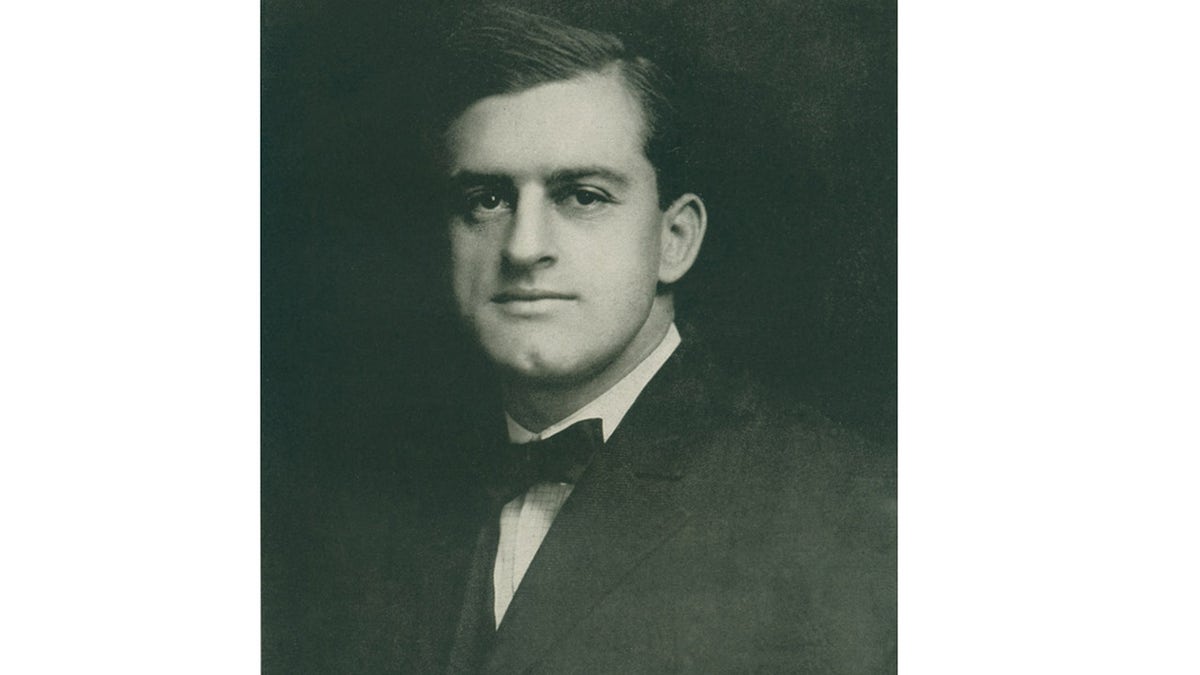
Eddie B. Cochems, Physical Education Instructor and Football Coach at Saint Louis University (1906) (Courtesy St. Louis University Archives)
The first pass in the history of football fell incomplete. It was a turnover by the rules of the time.
Robinson’s second pass proved the potential for aerial fireworks ahead. He hit teammate Jack Schneider for a 20-yard score — the first touchdown pass in football history.
MEET THE AMERICAN WHO WAS REVERED AS THE ‘PATRON SAINT’ UNTIL HE WAS CANCELED: LENNI LENAPE CHIEF TAMMANY
“Robinson was an end and I was a fullback. But Brad could throw the ball a long way, so we switched positions for that one play,” Schneider recalled 50 years later for the St. Louis Post-Dispatch.
“We were told to run after the snap and just keep going until we heard the passer yell ‘hike’ or our name. So, I ran and ran. I was about to give up when I heard Robinson call. I turned and caught the ball a yard or so short of the goal and went over with it.”
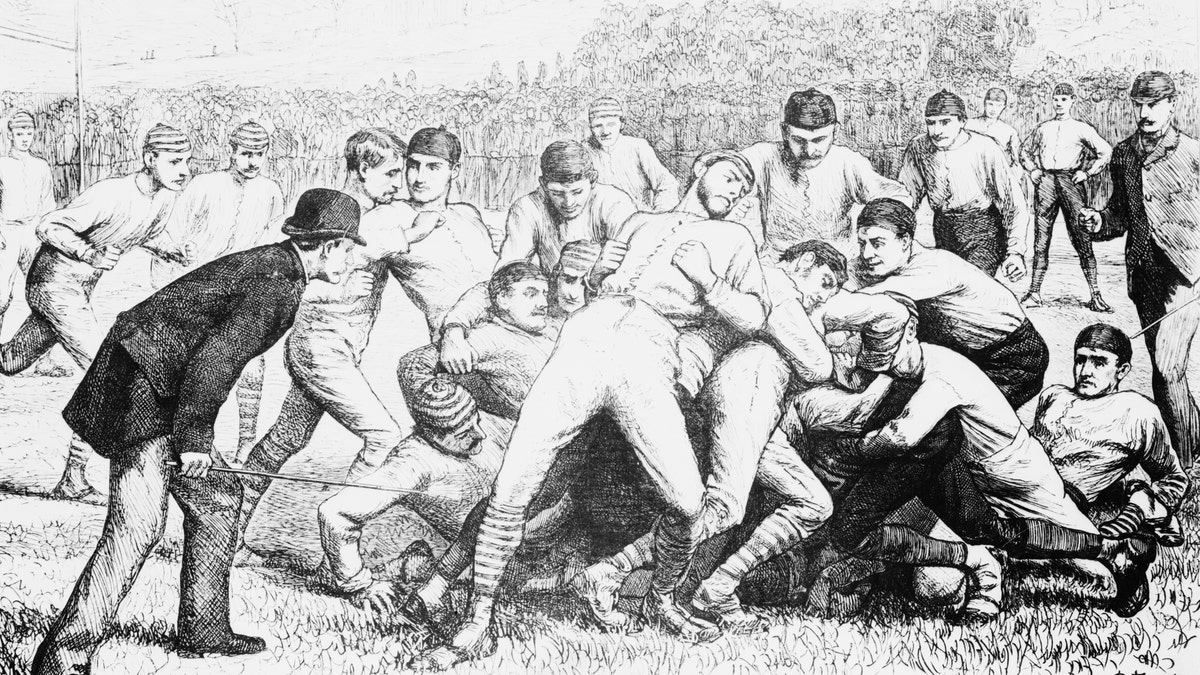
Football match between Yale and Princeton, 1879. Walter Camp was captain of the 1879 Yale football team. Drawing by A.B. Frost. (Getty Images)
“Somebody had to be the first. Somebody had to take the risk and show the football world what the forward pass could do,” author Miller said of the transformational moment in sports history.
“I bet it was pretty exciting.”
Armed with a new weapon, the Blue and White went 11-0 and savaged opponents by a combined score of 407-11.
The game of football was off and flying.
Robinson thrilled football fans later in the season with 48-yard completion against Kansas University. It was an unfathomable achievement in a sport that only one year earlier had been a deadly war of attrition.
Football was taking off and flying.
A legend nearly lost
Bradbury Robinson died in Florida on March 7, 1949. He was 65 years old.
He served as a captain in the U.S. Army in World War I, after his football heroics, and is buried at Arlington National Cemetery.
CLICK HERE TO SUBSCRIBE TO FOX NATION
He enjoyed a distinguished career as a physician. Among other accomplishments, he worked in Europe after the war for U.S. Surgeon General Hugh S. Cumming.
Robinson was also credited in the 1940s as one of the first medical professionals to alert the world of the dangers of insecticide DDT in agriculture.
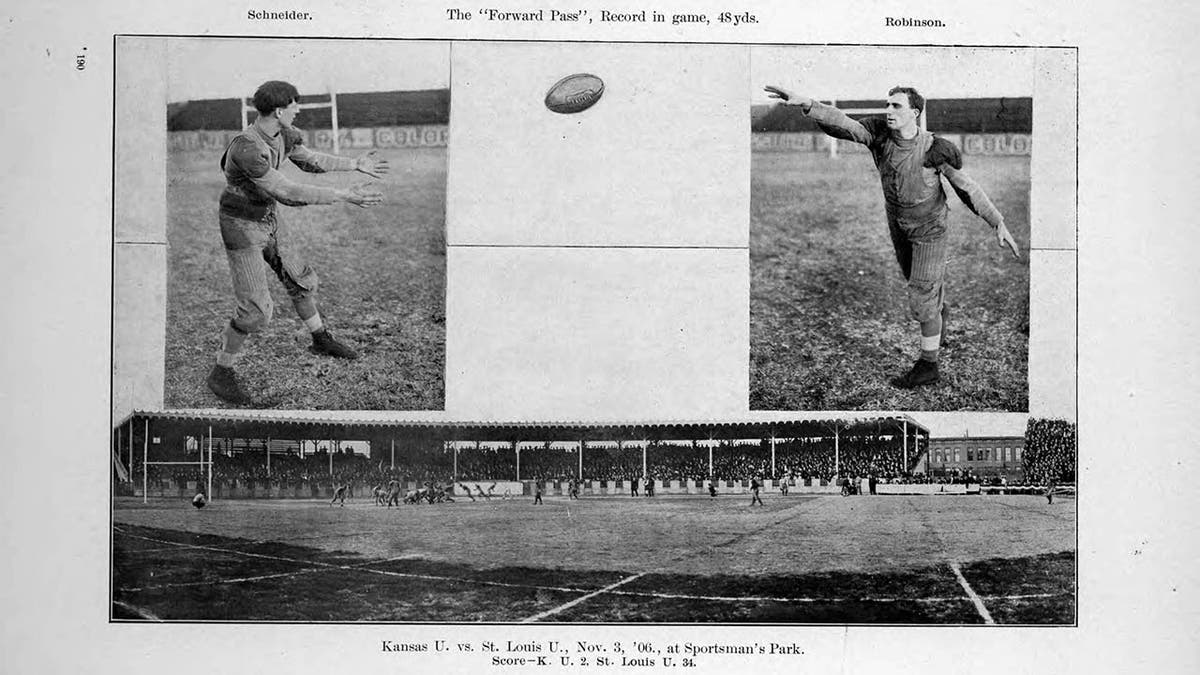
St. Louis University star Bradbury Robinson introduced the forward pass to football in 1906. SLU went 11-0 and stunned fans with a 48-yard pass against Kansas University. (Courtesy St. Louis University archives)
Robinson’s legacy as pigskin pioneer was nearly usurped by a legendary moment in football history.
The forward pass enjoyed a public relations coup in 1913. A little-known Catholic school from Indiana used the tactic to shock an eastern power in front of New York City media at West Point.
“The forward pass made the game both safer – and more exciting.”
Upstart Notre Dame smashed mighty Army, 35-13, as end and future coaching legend Knute Rockne caught two touchdown passes from Gus Dorais.
“The Westerners flashed the most sensational football that has been seen in the East this year,” The New York Times wrote of the event, “baffling the cadets with a style of open play and perfectly developed forward pass, which carried the victors down the field at 30 yards a clip.”
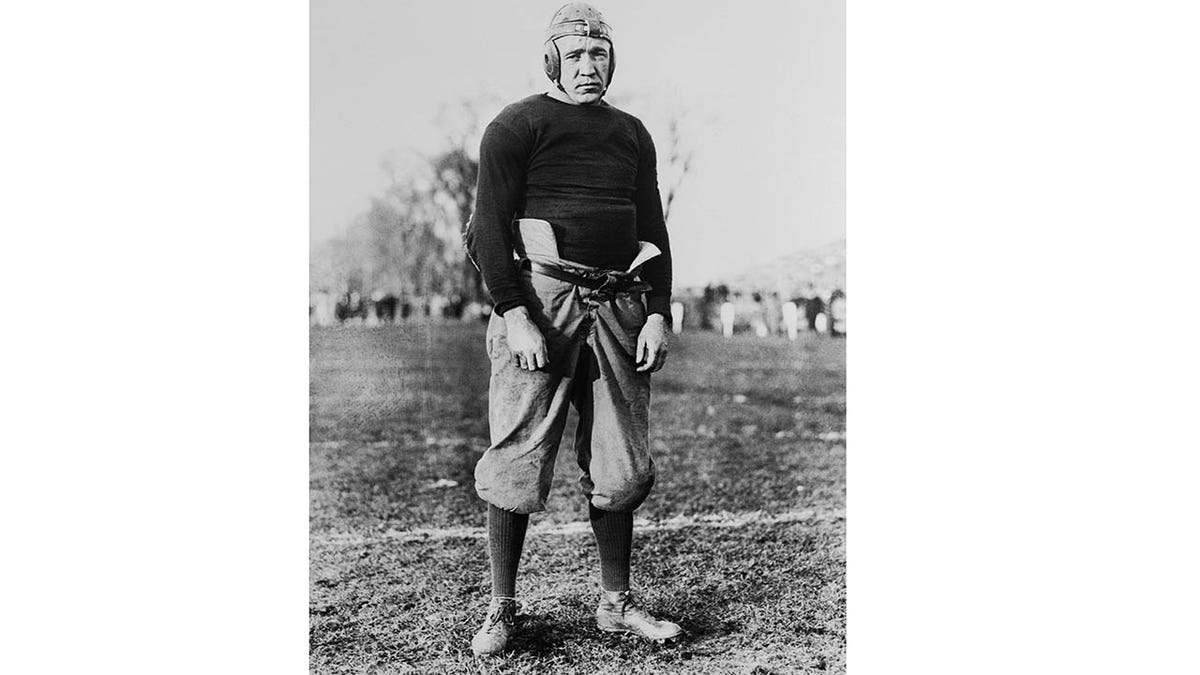
Knute Rockne is pictured here, as he appeared while he was captain of the Notre Dame football team. (Getty Images)
The forward pass perfected by small western schools had finally caught the attention of the eastern football establishment.
Notre Dame’s legend and affillation with the forward pass was cemented by the celebrated 1940 movie “Knute Rockne, All American,” starring Ronald Reagan.
Yet the claim to fame rightly belongs to St. Louis University, a school of firsts, said archivist Stamm.
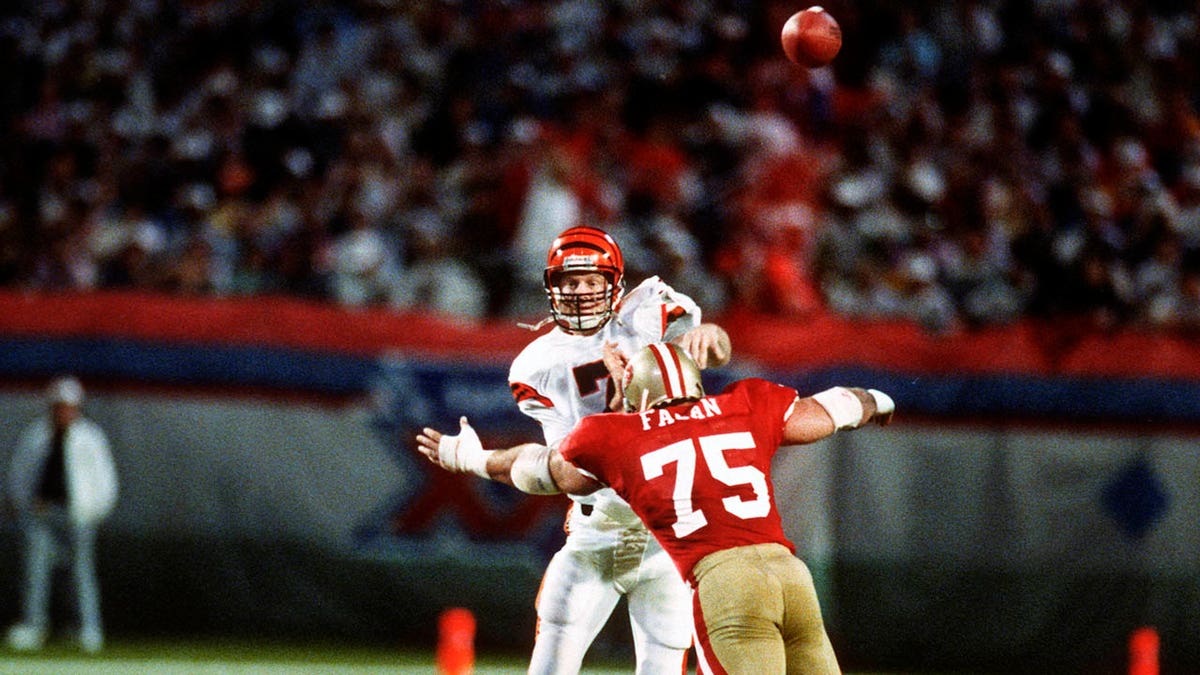
Boomer Esiason, No. 7 of the Cincinnati Bengals, gets his pass off while under pressure from Kevin Fagan, No. 75 of the San Francisco 49ers, during Super Bowl XXIII on Jan. 22, 1989 at Joe Robbie Stadium in Miami, Florida. The 49ers won that Super Bowl 20-16. (Focus on Sport/Getty Images)
The institution, she noted, was both the first university and first medical school west of the Mississippi River; it was also the first federally recognized aviation school.
“It’s a long tradition of excellence and firsts,” she said. “Even in a sport we don’t participate in anymore, the forward pass is still a part of our heritage.”
The forward pass, said Miller, made the game both safer and more exciting.
Former NFL quarterback and sports personality Boomer Esiason claims the forward pass made football a uniquely American game.
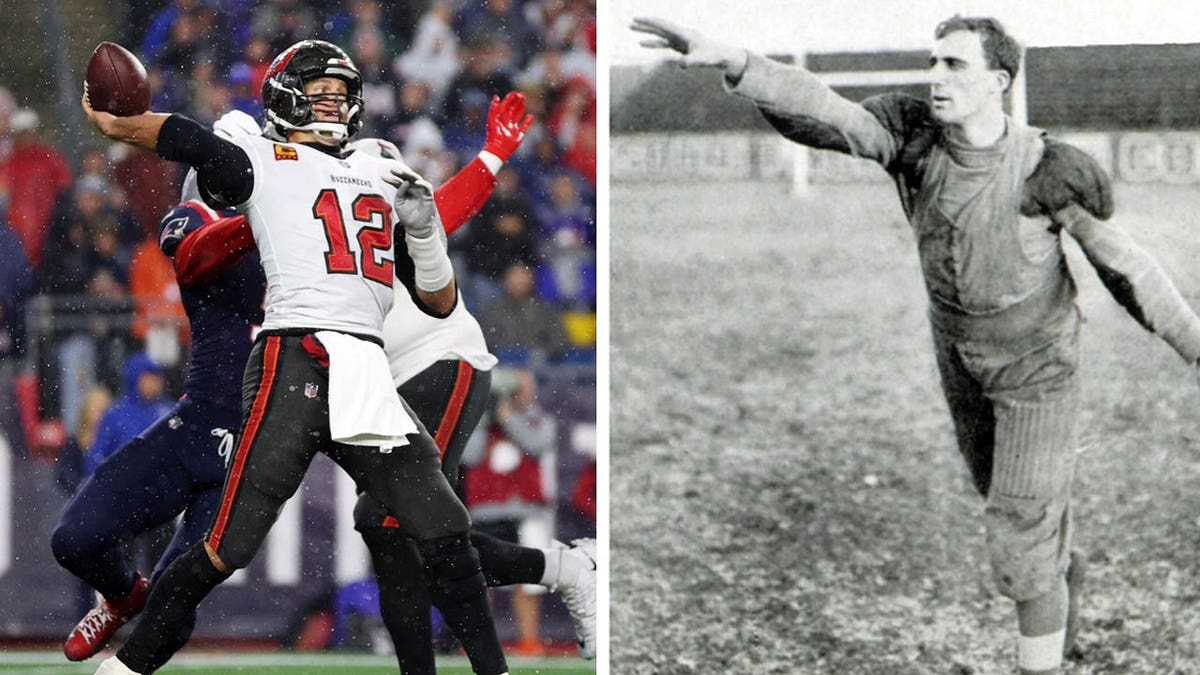
Tom Brady attempted 12,050 passes in his legendary NFL career; Bradbury Robinson threw the first very football pass in 1906. (Maddie Meyer/Getty Images; Courtesy St. Louis University archives)
“Other countries don’t do this. They play rugby. They flip it back. They play soccer. They kick it,” Esiason said during the NFL Films production “A Football Life: The Forward Pass.”
To read more stories in this unique “Meet the American Who…” series from Fox News Digital, click here.
“We Americans are all about freedom and liberty. We can flip it back. We can kick it. But more importantly, we can throw it. Nobody can throw it like an American.”
Read the full article from Here

South Dakota
Rapid City’s legion teams finish regular season Saturday

RAPID CITY, S.D. (KOTA) – Post 22 finished off the weekend with a sweep against Post 15 West of Sioux Falls, whereas Post 320 fell in straight games to Post 15 East. Saturday was the final day of the regular season for both Rapid City teams. The Hardhats and Stars look ahead to regionals which are happening this next week.
See a spelling or grammatical error in our story? Please click here to report it.
Do you have a photo or video of a breaking news story? Send it to us here with a brief description.
Copyright 2024 KOTA. All rights reserved.
Wisconsin
Wildfire smoke moving into Wisconsin

Highs in the mid 80s and sunny skies on Saturday!
We could see a couple of rain showers or thunderstorms in Northeast Wisconsin Saturday evening. No severe weather is expected.
This is due to a cold front draped over Northern Wisconsin. The front is also bringing some wildfire smoke to much of the Upper Midwest! This will cause minor impacts to Wisconsin – air quality could decrease.
Sunday comes with a chance for isolated showers across the neighborhoods with highs near 80 degrees.
Mostly Sunny conditions on Monday as highs climb into the low 80s.
A couple of rain showers and storms as we head into next week. Tuesday looks to have the best chance for widespread rain.
Detroit, MI
Pucks for Autism faces Detroit Red Wings alumni in charity game at Notre Dame

SOUTH BEND, Ind. (WNDU) – Notre Dame’s Compton Family Ice Arena played host on Saturday night to a hockey match between the Pucks for Autism team and alumni of the Detroit Red Wings of the NHL.
This event is part Pucks for Autism charity games, in which the organization travels to various hockey arenas across the country to promote autism acceptance during the 2024-25 NHL season.
“Pucks for Autism is a 501(c)(3) charity that my husband and I started in honor of our son, Henry,” explained Eva Pheiffer. “From that, we have grown exponentially from being just a small tournament once a year. We now have our large tournament every year in June, but we also have several tournaments throughout the year, like this one where we raise money and donate to local charities or local facilities that also assist with special needs children and adults.”
Pucks for Autism welcomes players of all skill levels and abilities to join them for the once-in-a-lifetime opportunity to play on NHL ice.
Proceeds from Saturday night’s game will benefit Camp Milhouse, which has deep roots here in Michiana as a residential camp for people with disabilities.
Copyright 2024 WNDU. All rights reserved.
-

 News1 week ago
News1 week agoHow Democrats Will Choose a Nominee
-

 World1 week ago
World1 week agoWill the NATO Washington summit deliver for Ukraine?
-

 News1 week ago
News1 week agoVideo: Biden ‘Is a Fighter,’ Harris Says in North Carolina
-
News1 week ago
After a tragedy, a mother wants to soften the rooms where police interview victims
-

 Politics7 days ago
Politics7 days agoTwo key states to see massive GOP voter registration operation
-
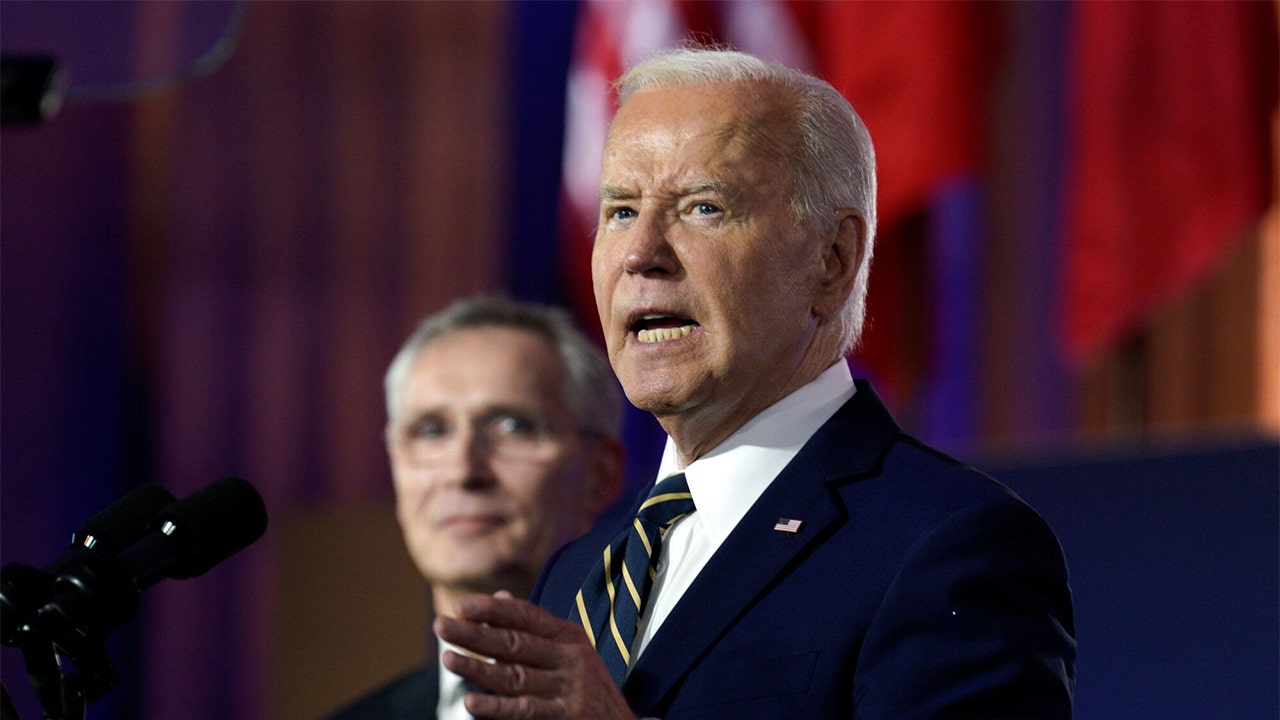
 Politics1 week ago
Politics1 week agoBiden's 'big boy' NATO news conference carries high stakes as first presser since disastrous debate
-

 World1 week ago
World1 week agoJapan, Germany agree to boost security cooperation in Pacific
-

 Movie Reviews1 week ago
Movie Reviews1 week agoFilm Review: Fly Me to the Moon – SLUG Magazine
